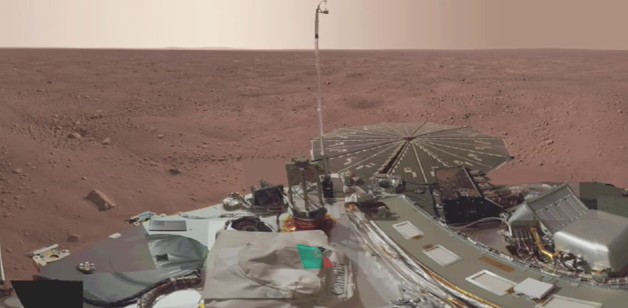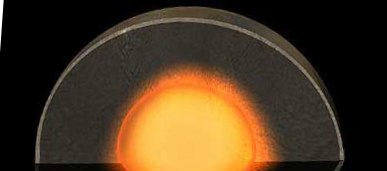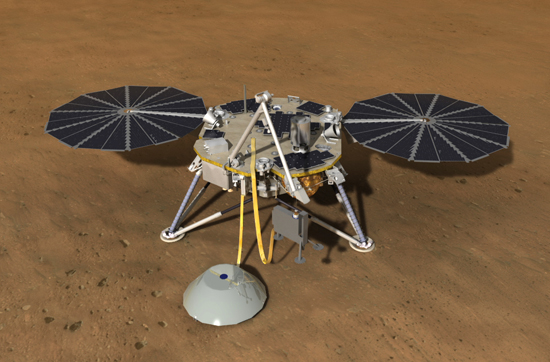Analyzing data using tools, technology and models to construct explanations
Relevant Math, Science and Language Standards
(NGSS.SEP:2,4,5,7) Developing and using models; Analyzing and interpreting data; using mathematics and computational thinking; Engaging in argument from evidence
(CCSSM.MP.4) Model with mathematics.
(CCSS/ELA. RTS.11-12.2) Determine the central ideas or conclusions of a text; summarize complex concepts, processes, or information presented in a text by paraphrasing them in simpler but still accurate terms.

Using Technology to Make Discoveries on Mars
Find out about the technology on the Mars Phoenix Lander that helps NASA remotely explore the distant planet. Learn about the filters that are used to obtain color images, and the high-tech oven that proved the existence of water ice on Mars. [Open Video]

Select 1-page problems appropriate for student's exploration of the math involved with the science theme.
1-Exploring Earth's Chandler Wobble....[Link]
2-Motion of Planetary Poles....[Link]
3-Properties of Mars as a Planet....[Link]
4-Travel Time to Mars by Radio....[Link]

Marsquakes:
Red Planet May Still Rumble (October 11 2004:
Space.com)
Mars used to be a mover and a shaker. Scientists don't know if it still entertains seismic activity, however. No mission has ever been equipped to properly measure any rattling that might still occur. Now a study comparing images of intriguing pits on Mars to similar features on Earth suggests the red planet indeed still rumbles.
"It's likely that there may be marsquakes today, but seismic monitoring will be required to know for sure," said study leader David Ferrill of the Southwest Research Institute in San Antonio, Texas. "Until then, it's just scientific speculation." Ferrill and colleagues at the University of Texas examined images from Mars-orbiting satellites that show strings of depressions -- pits all in a row. Scientists had thought the pit chains, as they are called, might be collapsed lava tubes or sinkholes created when the surface collapses into underground tunnels carved by water.
There are similar pit chains in Iceland, however, that formed along a fault that began shifting in 1975. Aerial photographs in the decades since detail the pits' collapse and, importantly, how erosion and weathering began to erase them, Ferrill explained. [More]
Additional Press Releases:
1-Candidate Sites for 2016 Mars Mission...[Link]
2-InSight Development Milestone...[Link]
3-Extensive Water in Mars Interior ...[Link]
4-Sensor Design Inspired by Lobsters...[Link]
5-A New Martian Impact Crater Appears...[Link]
6-Reservoir for Mars Water Discovered...[Link]
Guide your students to create their own problems using the information found in the press release or video program. Use this as a check of their understanding.
The Motion of Planetary Rotation Poles - The rotational pole of a planet does not remain fixed, but can move in complex cycles over time. As the gyroscope spins under the force of gravity, its axis turns through a circle, called precession. The motion of water in the oceans, and the interior layering and composition of Earth also cause a faster motion called the Chandler Wobble.In this lab module, you will examine the nutation and Chandler Wobble of Earth and Mars, and determine the periods of this motion. (.xlsx file)
Exploring Earth's Chandler Wobble - In addition to precession and nutation, there is a third motion of Earth's North Pole called the Chandler Wobble and has a period of about 430 days, and a radius of about 9 meters. The Chandler Wobble is caused by the way that the spin of Earth reacts to the movement of ocean water, and air in the atmosphere. The lab module will show how studying the Chandler Wobble tells scientists a lot about the surface and interior of Earth. [Grade: 8-10 ] (.xlsx file)
Basic Properties of Mars as a Planetary Body - We can't visit the interior of Mars, or any other planet for that matter, but there are ways we can explore a planet's interior just by knowing a few basic things about it. In this lab module, you will create a model of the interior of Mars by knowing three basic things about its bulk properties: Its mass, its density and its moment of inertia. (.xlsx file)
A Round-trip Message to the InSight Lander on Mars - Even at the speed of light, communicating with the InSight lander will not be 'instantaneous'. Astronomers plan to use sensitive 'radio telescopes' on Earth to accurately measure this time delay so that they can figure out exactly how Mars rotates. By measuring the very slight millimeter changes in this rotation over time, they will be able to study how much the core of Mars sloshes about in its liquid state. This is like watching very carefully how a fresh egg spins compared to a hard-boiled egg. This lab module will demonstrate how the timing of the signals depends on the placement of the lander at specific locations on Mars.(.xlsx file)
Evaluate student's understanding of how math, science and technology work together to increase our understanding of Mars (e.g marsquakes, interior, heat flow) through formative or summative assessments.